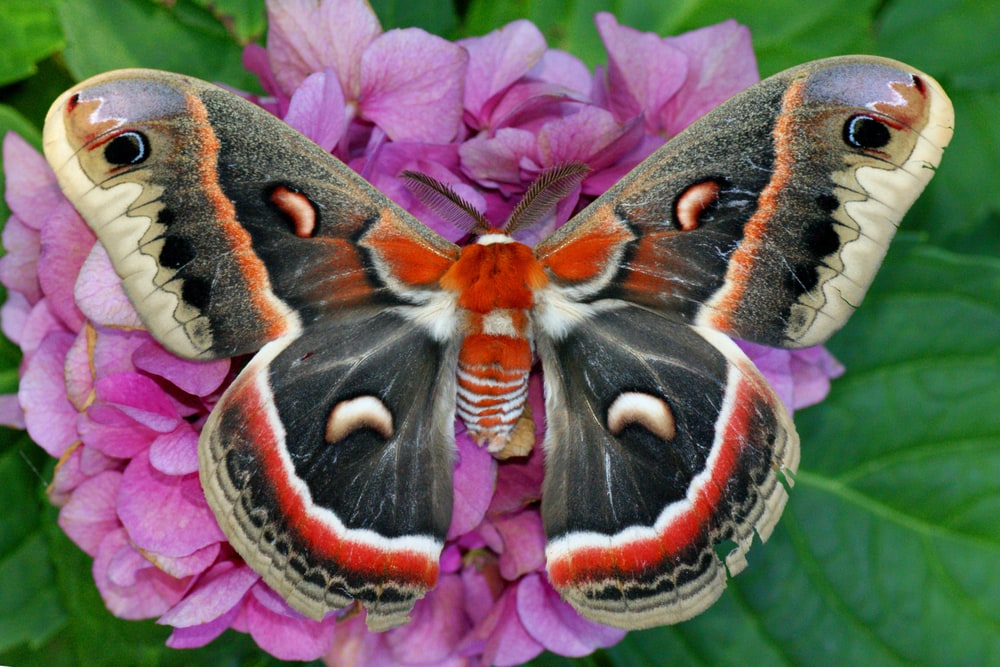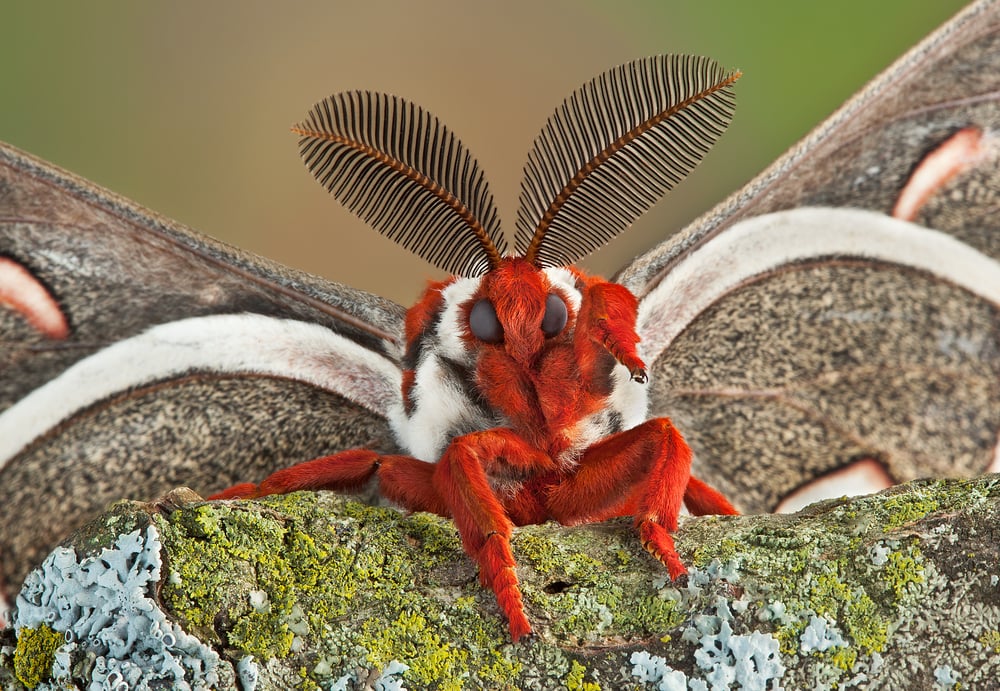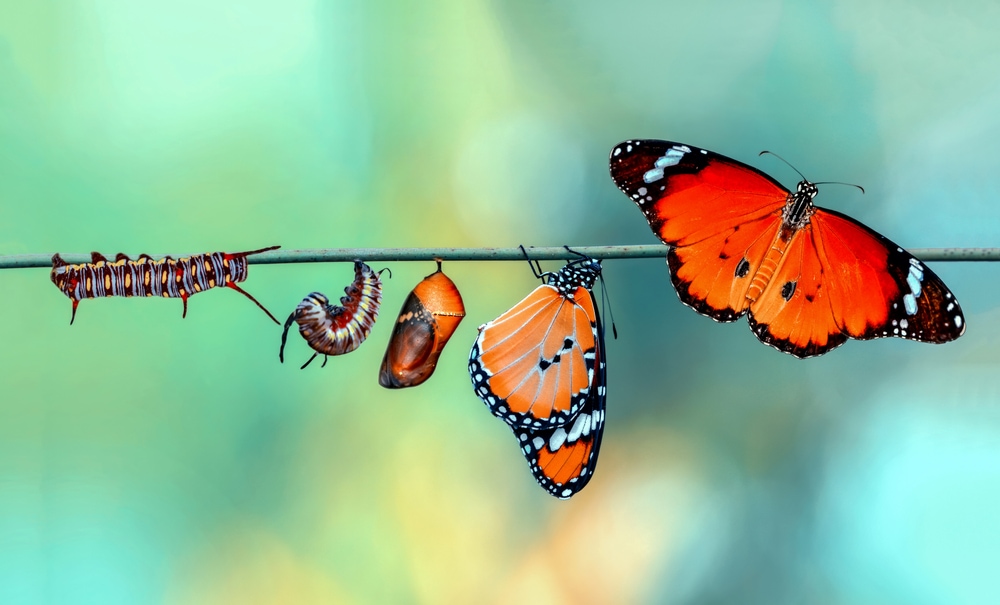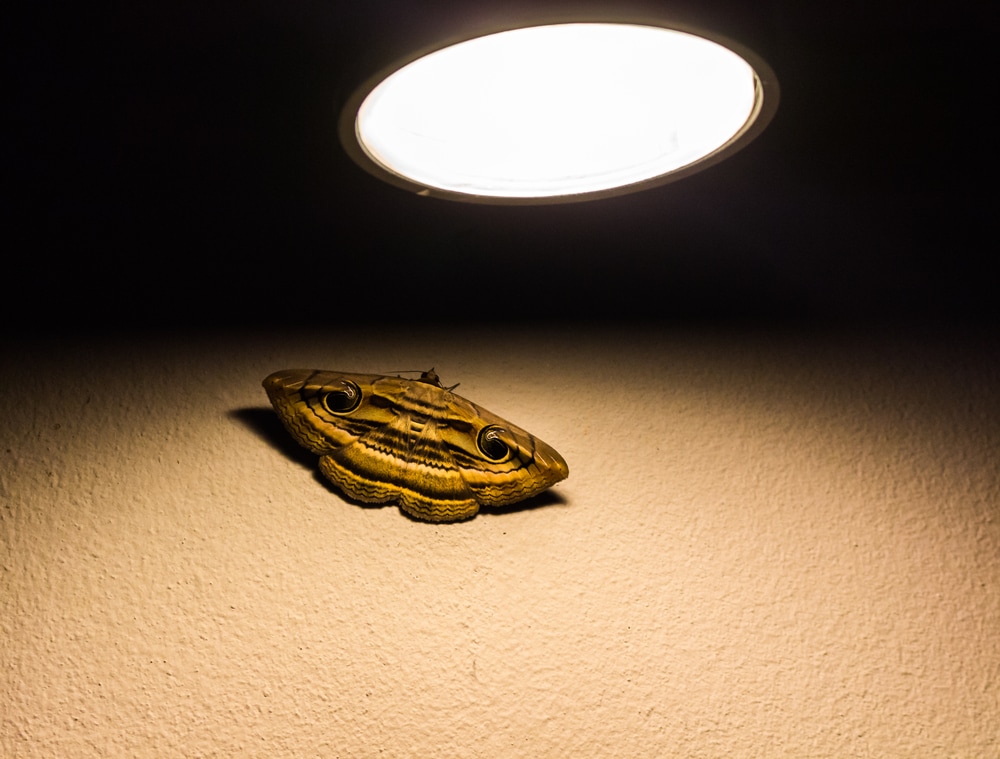Outforia Quicktake: Key Takeaways
- Moths and butterflies belong to the insect order Lepidoptera, with moths being more numerous in species.
- Main differences include wing color and size, behaviors, pupa, antennae, and anatomy.
- Both insects have a metamorphic life cycle and are important pollinators.
- The lifespan of moths and butterflies varies depending on the species and their ability to eat.
- Moths and butterflies are essential to ecosystems and the food chain, with numerous predators feeding on them.

More than 150,000 moths and butterflies flutter around several parts of the world. But what’s the difference between a moth vs. butterfly?
These insects have many similarities as they share the same order and possess similar features. But they have a number of differences that can help you distinguish them from each other.
Most species have differences in appearance, behavior, and life cycle changes. One of the most identifiable differences between moths and butterflies is their wings and body shape.
In this article, we’re going to explore some key differences between moths and butterflies.

SHARE THIS IMAGE ON YOUR SITE
<a href="https://outforia.com/moth-vs-butterfly/"><img style="width:100%;" src="https://outforia.com/wp-content/uploads/2022/11/moth-vs-butterfly-infographics-11222022.jpg"></a><br>Moth vs Butterfly <a href="https://outforia.com">Outforia</a>Scientific Family of Moths vs. Butterflies

Both moths and butterflies belong to the insect order Lepidoptera. There are significantly more moth species and families of moths than different types of butterflies.
There are a few characteristics that species in this order have in common. All moths and butterflies have scales on their wings. Like most insects, moths and butterflies have a metamorphic life cycle.
The term Lepidoptera derives from Greek, meaning scale and wing. Moths and butterflies are considered very important species to the environment. They’re also considered a successful group of insects. Moths and butterflies can be found worldwide in a wide variety of habitats.
You May Also Like: 33 Types Of Caterpillars: From The Fuzziest To The Spikiest (Names, Pictures, Facts)
5 Differences Between a Moth vs. Butterfly

Although moths and butterflies belong to the same order, they have a number of differences. Many of their differences are identifiable by their appearance.
The main differences between moths and butterflies include their wings, anatomy, behaviors, and pupil stage.
1. Moth vs. Butterfly: Wing Color and Size

If you’ve ever seen moths and butterflies, you might know that they have significant color differences. Moths typically have dull-colored wings. Butterflies usually have intricate wing patterns with vibrant colors.
This difference in wing color applies to most moth and butterfly species. However, some moth species have vibrant colors, such as the luna moth. The luna moth boasts bright green wings with a dark edge and light yellow near the head.
Butterfly wings are larger than most moth species. However, there are a number of moth species that have a large wingspan.
For example, the Atlas moth is the largest known moth species in the world. It has a wingspan of more than 10 inches (25 cm).
2. Moths and Butterflies Have Different Behaviors

Moths and butterflies go through similar life processes. However, they have a number of behavioral differences. Most butterflies are diurnal. This means they’re most active during the day.
Moths are nocturnal, meaning they’re most active at night. This makes it easier to determine between a moth and a butterfly, depending on the time of day. To make things a little more complicated, some moths are diurnal. Some butterflies are active at dawn and dusk.
Moths and butterflies have different resting postures. Moths can be found relaxing with their wings spread flat. Butterflies rest with their wings closed above the body.
Some moth species hold their wings up, such as geometrid moths. Some butterfly species rest with their wings flat like moths, such as the subfamily Pyrginae.
3. Moths and Butterflies Have Different Pupa

The pupa is the stage of the butterfly and moth life cycle, where these creatures transition into adults. Although the life cycle stages of moths and butterflies are similar, they have different formations in this stage.
Many moth species form a cocoon to reorganize into an adult. Cocoons are soft and made of silk produced by the caterpillar, or larva, of a moth.
Butterflies don’t create cocoons. They form a chrysalis. A chrysalis has a similar shape to a cocoon, but it’s hard and smooth.
Some moth and butterfly larvae don’t make cocoons or chrysalids. Instead, they burrow into the ground or hide under leaf litter to pupate.
4. Butterfly and Moth Antennae Look Different

One of the easiest ways to distinguish a moth and a butterfly up close is their antennae. Butterfly antennae are long, and most have round bulbs at the end of each antenna.
Moth antennae usually have side branches that have a feathery or saw-edged appearance. They don’t have bulbs on the end of their antennae. Butterfly antennae don’t have a feathery appearance.
5. Anatomy of a Moth vs. Butterfly

A butterfly’s body is typically long and slender. They also have long skinny legs. Moth bodies are usually more bulbous and aren’t as long as butterflies.
Butterfly wings are thinner than moth wings. Moths have a more fuzzy wing appearance because their wings have a thicker coating of scales. This is a result of their nocturnal behavior. Butterflies are able to stay warm from the sun during the day.
Moths need thicker wings to keep them warm at night. Moths and butterflies both vibrate their muscles to generate heat. Moths do this frequently to stay warm at night.
How Are Moths and Butterflies Similar

Moths and butterflies have many similarities. They both go through a metamorphic life cycle. Most moths and butterflies have the same diet. They drink nectar from flowering plants. We typically don’t see moths eating nectar from flowers because they do so at night.
Due to their diet, moths and butterflies are both pollinators. Although they share the same diet, some moths don’t eat at all.
Many moth species, such as the Atlas and luna moths, don’t have mouths. This causes them to have a very short lifespan compared to other species.
Moths and butterflies both have scales that cover their wings and body. Some moth and butterfly species also share migratory behaviors. These migratory moths and butterflies can travel long distances.
Moths and butterflies are thought to have co-evolved with each other. Their evolution is based upon the evolution of flowering plants.
Butterflies and moths share some of the same predators. Birds, lizards, and amphibians are some of the top predators for moths and butterflies.
Life Cycle of Moths vs. Butterflies

Moths and butterflies have four main stages in their life cycle. They go through a process called metamorphosis, like most insects.
The life cycle begins when moths and butterflies lay eggs. These eggs hatch into larvae. Moth and butterfly larvae are commonly referred to as caterpillars.
Most of a caterpillar’s life is spent eating plant matter. They mainly eat leaves, flowers, fruits, stems, and roots.
The larvae stage is the only point in the life cycle in which they grow. They form new skin under their old skin and molt multiple times before reaching their full size. The time it takes for a caterpillar to reach its full size depends upon the specific species. It can take weeks or longer.

The next stage in the life cycle is the pupil stage. During this stage, a caterpillar turns into a pupa. Some species seek shelter under leaf litter or burrow into the soil to pupate. Other species build a cocoon or chrysalis.
Moths create a cocoon out of silk to pupate. Butterflies create a hard, smooth shell to pupate. Inside the casing, a caterpillar breaks itself down on a cellular level. It reorganizes itself into an adult butterfly or moth. This is when they grow adult wings, legs, and eyes.
Most moths and butterflies take two weeks or less to emerge from their cocoon or chrysalis.
The last stage of the cycle starts when moths and butterflies emerge from their cocoon or chrysalis. They emerge as full-grown adults. They spend a little time expanding their crumpled wings after they emerge.
Some species, such as the belted beauty moth, don’t have wings. These species don’t travel very far from their pupa case. As adults, butterflies and moths begin drinking nectar from flowers and looking for mates.
You May Also Like: 16+ Different Types Of Bees: Field Guide Identification With Photo, Facts And More
Life Span of Moths vs. Butterflies

The lifespan of a butterfly and moth can differ depending on the species. One year typically equals one generation for moths and butterflies. Most moths and butterflies live no more than a year. Many species have a much shorter lifespan.
Some moths have a very short lifespan because they can’t eat. For example, the luna, Atlas, and Promethea moths don’t have mouth parts. They also don’t have a digestive tract. The energy they use to survive comes from the energy they stored when eating as a caterpillar.
The sole purpose of moths without mouth parts is to reproduce. Moths and butterflies that have mouth parts possess a proboscis.
A proboscis is a long, tongue-like appendage that moths and butterflies use to drink nectar from flowers. It coils up when they’re not using it and extends out to reach nectar when they feed.
Most moths and butterflies that can eat live for about one month or less. Some may live for several months, depending on when they emerged and other environmental conditions. However, their lifespan can be shortened significantly by predation.
Reproduction of Moths and Butterflies

Adult moths and butterflies mate, and females lay eggs. The number of eggs a moth or butterfly lays can depend on the species or other environmental factors. They can lay anywhere between 100-400 eggs. They lay many eggs to increase the chances of more caterpillars hatching.
It usually takes up to one week for moth and butterfly eggs to hatch. But this can differ depending on the species and time of year.
Most moths and butterflies lay their eggs at a time when caterpillars will emerge with plenty of food sources. This allows caterpillars to have enough food to eat so they can develop properly and prepare for the pupil stage.
Impacts of Butterflies and Moths on the Environment

Butterflies and moths are very important to the environment. They’re key pollinators. Butterflies and moths help pollinate plants by traveling from one plant to another, drinking nectar. In the process, they spread pollen. Pollination is very important for plants to produce new seeds.
Moths and butterflies are also pollinators of flowers that bees may not visit.
These creatures also promote plant biodiversity. Having butterflies and moths fluttering in your garden is a sign of a healthy environment.
On a more broad scope, butterflies and moths are essential to the ecosystems they live in. Diminishing moth and butterfly populations can negatively affect many other creatures.
Many animals rely on plants as a food source, which butterflies and moths help pollinate. Butterflies and moths are also a main food source for numerous animals.
Habitat fragmentation and climate change can drastically affect moth and butterfly populations. They’re sensitive to unnatural and changing conditions. This makes them vulnerable to climate change and habitat loss.
Importance of Moths and Butterflies to the Food Chain

Moths and butterflies stand pretty low on the food chain. This is because they aren’t predatory, but they have many predators. Numerous bird species feed on moths and butterflies. Reptiles, amphibians, and small mammals also feed on them. Moths are a key food source for bats.
Moths have evolved to combat bat predation. Bats can seek out moths using echolocation.
Some moths have “ears” that allow them to detect the sounds bats produce. Moths can change flight patterns to avoid being scooped up by bats. Some moths also make noises to confuse bats.
Parasitic wasps and flies also play a role in the food chain with caterpillars. The larvae of parasitic wasps and flies feed on caterpillars. This is known as parasitism, which is a type of symbiotic relationship. Although caterpillars don’t benefit from this relationship, it does benefit the parasitic larvae.
Are Butterflies Attracted to Light Like Moths?

If you have an outdoor light, you may have noticed how moths flock toward the light at night. One theory is that moths are attracted to light because of navigational orientation. They may navigate in a constant direction based on the distance of a light source.
Since moths appeared hundreds of millions of years ago, they used only natural light at one point. The creation of artificial light can cause moths to be confused. This is why artificial lights attract moths.
Butterflies aren’t typically seen fluttering around artificial lights because most species are active during the day. But butterflies are attracted to light, just like moths. It’s just not as apparent because they aren’t nocturnal.
You May Also Like: 17+ Species Of Poisonous Caterpillars Found Around The World
Moth vs Butterfly FAQ

Why is the butterfly more common than the moth?
Butterflies are more common than moths because people tend to appreciate the beauty of butterflies more than moths. They’re also seen more often in the spring and summer because we’re more active during the day. In the perspective of population and species, moths are more common than butterflies.
There are more than 150,000 known species of moths and butterflies in the order Lepidoptera. Butterflies make up about 18,000 of these species. There are many more moth species than butterflies.
Do moths come from caterpillars?
Yes, moths come from caterpillars, just like butterflies. Moths have the same life cycle as butterflies and go through the same metamorphic stages. Identifying a moth caterpillar versus a butterfly caterpillar can be difficult.
Most moth caterpillars are fuzzy and have tiny hairs. Many butterfly caterpillars are smooth with little to no hair. However, some smooth caterpillars may be moths.
Why is a moth uglier than a butterfly?
Some may think moths are uglier than butterflies because they lack vibrant colors. A moth lacks vibrant colors due to high concentrations of melanin in its scales. But there are many beautiful moths in the world.
The sunset moth native to Madagascar is a day-flying moth with vibrant colors. It was originally mistaken for a butterfly due to its vibrant colors, wing shape, and daytime activity. Some consider it one of the most beautiful insects in the world.
What is the biggest butterfly in the world?
The biggest butterfly in the world is the female Queen Alexandra’s birdwing. They’re about the same size as Atlas moths, with a wingspan of around 10.6 inches (27 cm). It lives in the rainforests in northern Papua New Guinea. Queen Alexandra’s birdwing is an endangered species.
Where do moths and butterflies sleep?
During the day, moths hide in a safe spot to sleep. They typically rest in a spot out of direct sunlight under leaves in trees or bushes. Most butterflies find a leaf or twig to hang from at night to sleep. Moths and butterflies try to stay hidden when they sleep to prevent being eaten by predators.









